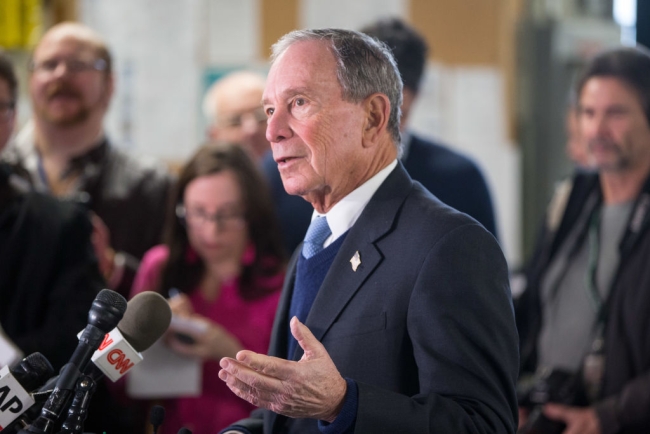You have /5 articles left.
Sign up for a free account or log in.

Michael Bloomberg, who is seeking the Democratic presidential nomination
Getty Images/Scott Eisen
In proposing a plan for providing free higher education and forgiving student debt -- but not for all borrowers -- New York billionaire Michael Bloomberg on Tuesday drew a contrast as he has in other policy areas with the more progressive candidates vying for the Democratic presidential nomination, Bernie Sanders and Elizabeth Warren.
But Bloomberg's proposal also is significantly different than those from other more centrist candidates in how they’d deal with other issues like reducing student loan repayments, said Wesley Whistle, New America’s senior adviser for education policy and strategy, and other higher education experts.
An example is the question of forgiving student debt. While Sanders would cancel all debt and Warren would entirely eliminate the loans of more than 75 percent of borrowers, reducing them for 95 percent, Bloomberg’s plan called for a more limited approach, restricting debt forgiveness to borrowers who went to failed or predatory for-profit colleges.
He would also enroll current and future borrowers in income-based repayment plans and forgive balances, tax-free, if borrowers made progress on paying down their student loan debt for 20 years. His campaign said the plan would increase the number of people who will have their loans forgiven because everyone will be automatically enrolled. Bloomberg also would lower the monthly rate borrowers on income-based plans have to repay, from the current rate of 10 percent of their discretionary income to 5 percent.
However, former vice president Joe Biden would go further. While his plan would also lower repayment to 5 percent of discretionary income, borrowers making $25,000 or less annually wouldn’t have to make any payments on their federal undergraduate loans. And he would forgive loans for students who were deceived by for-profit colleges by restoring the Obama administration’s borrower-defense rule.
The idea of lowering the income-driven repayment rate, however, has its critics, including Sandy Baum, a nonresident senior fellow for the Urban Institute's Center on Education Data and Policy and a professor emerita of economics at Skidmore College, who advised Hillary Clinton’s 2016 campaign. Bloomberg’s plan “goes too far on reducing loan repayment rates because borrowers would end up paying back a small fraction of what they owe” due to balances being forgiven after 20 years, she said in an email.
Senator Amy Klobuchar’s education proposal, however, does not mention lowering payments in the same way, but would allow borrowers to refinance their student loans. The Minnesota Democrat also would expand the Public Service Loan Forgiveness program to more in-demand occupations.
Former South Bend, Ind., mayor Pete Buttigieg’s proposal would automatically enroll borrowers in income-based plans if they are struggling to make payments, but does not mention lowering the repayment rate. He also would accelerate the cancellation of student debt for government and nonprofit workers.
On tuition-free college, Bloomberg joins all the major Democratic candidates in proposing to make community colleges free.
However, departing from Klobuchar and Biden, Bloomberg joined Buttigieg in going a little further and also making public four-year institutions free, at least for some students.
Bloomberg and Buttigieg’s proposals also differ in how much to target free tuition at four-year institutions to those most in need.
Buttigieg made headlines in December by criticizing Sanders’s and Warren’s plans for making tuition free at all public colleges, saying even children of millionaires would benefit.
Instead, he proposed making public colleges tuition-free only for families who make less than $100,000. Students from families earning $100,000 to $150,000 per year would get tuition subsidies on a sliding scale under Buttigieg’s plan.
Bloomberg would take an even more limited approach, making public colleges free only for low-income families -- those making less than $30,000.
Like Biden and Klobuchar, Bloomberg called for doubling the maximum Pell Grant amount to $12,690. Buttigieg also called for a $1,000 increase to the maximum amount, but Whistle noted his plan is less reliant on the aid program.
None of Bloomberg's opponents mentioned in this article returned inquiries about his proposal.
Tamara Hiler, director of education at the center-left think tank Third Way, praised Bloomberg’s tack of limiting free tuition. “Having a plan that is more targeted in scope is not only less regressive and less expensive, but it’s also what Democratic primary voters said they would rather see in a candidate.” She cited a November online poll Third Way conducted of likely 2020 Democratic primary voters. It found greater support, 56 percent versus 44 percent, for providing free higher education for low- and moderate-income students instead of all students.
Like others interviewed about the proposal, Hiler didn’t endorse any single plan.
Another backing the limited approach was Terry Hartle, the American Council on Education’s senior vice president for government and public affairs.
“Given limited federal resources, we have believed that federal student aid funds should be focused on low-income and first-generation students. If at some unforeseeable future point there is no limit on available funds, we will revise our position,” he said in an email.
Neal McCluskey, director of the Cato Institute’s Center for Educational Freedom, also praised limiting free tuition but said the plan still is off track. “Bloomberg’s proposals are more reasonable than sweeping loan forgiveness or massive ‘free’ college,” he said, “but they still have the wrong basic prescription: more federal ‘help’ where less is needed. Federal student aid has fueled rampant price inflation, and this plan would only exacerbate that with bigger Pell Grants and encouraging more use of student loans.”
Meanwhile, Baum and Hiler praised Bloomberg’s plan for taking aim at improving college completion rates. As part of a federal matching program he’d create, Bloomberg said states would have to adopt programs aimed at improving competition, involving the use of advising, course scheduling, tutoring, childcare services, transportation and emergency financial assistance.
But Hartle, who backed increasing the maximum Pell Grant award, also cautioned that talk is cheap during campaign season.
“The basic rule of any campaign proposal is caveat emptor. Campaign proposals are easy, but enacting concrete changes in public policy of the sort the Democrats are discussing is really hard,” said Hartle. “While higher education welcomes the emphasis on affordability, we should not assume that any of these ideas are set in stone.”




